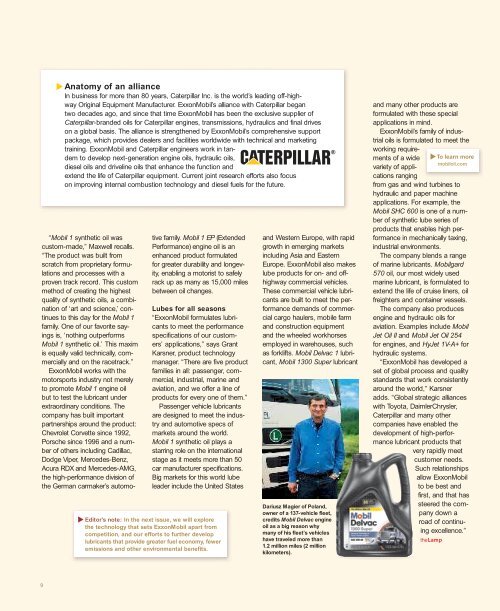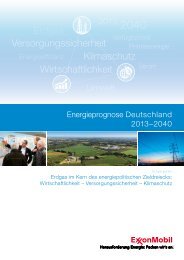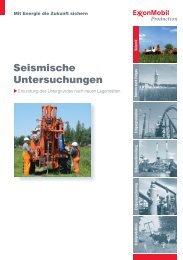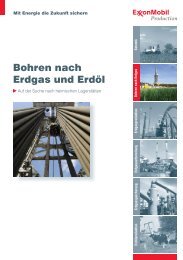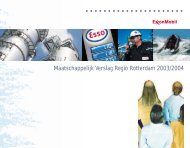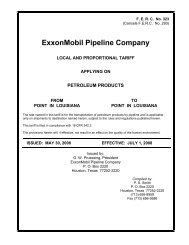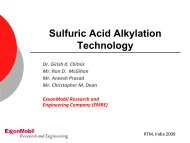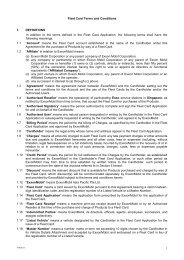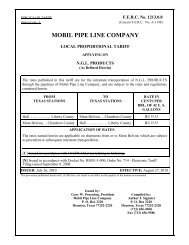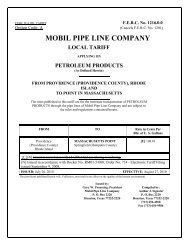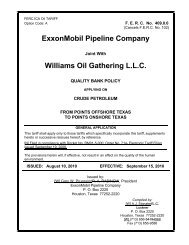The Lamp, 2007 - Number 3 - ExxonMobil
The Lamp, 2007 - Number 3 - ExxonMobil
The Lamp, 2007 - Number 3 - ExxonMobil
You also want an ePaper? Increase the reach of your titles
YUMPU automatically turns print PDFs into web optimized ePapers that Google loves.
Anatomy of an alliance<br />
In business for more than 80 years, Caterpillar Inc. is the world’s leading off-highway<br />
Original Equipment Manufacturer. <strong>ExxonMobil</strong>’s alliance with Caterpillar began<br />
two decades ago, and since that time <strong>ExxonMobil</strong> has been the exclusive supplier of<br />
Caterpillar-branded oils for Caterpillar engines, transmissions, hydraulics and final drives<br />
on a global basis. <strong>The</strong> alliance is strengthened by <strong>ExxonMobil</strong>’s comprehensive support<br />
package, which provides dealers and facilities worldwide with technical and marketing<br />
training. <strong>ExxonMobil</strong> and Caterpillar engineers work in tandem<br />
to develop next-generation engine oils, hydraulic oils,<br />
diesel oils and driveline oils that enhance the function and<br />
extend the life of Caterpillar equipment. Current joint research efforts also focus<br />
on improving internal combustion technology and diesel fuels for the future.<br />
“Mobil 1 synthetic oil was<br />
custom-made,” Maxwell recalls.<br />
“<strong>The</strong> product was built from<br />
scratch from proprietary formulations<br />
and processes with a<br />
proven track record. This custom<br />
method of creating the highest<br />
quality of synthetic oils, a combination<br />
of ‘art and science,’ continues<br />
to this day for the Mobil 1<br />
family. One of our favorite sayings<br />
is, ‘nothing outperforms<br />
Mobil 1 synthetic oil.’ This maxim<br />
is equally valid technically, commercially<br />
and on the racetrack.”<br />
<strong>ExxonMobil</strong> works with the<br />
motorsports industry not merely<br />
to promote Mobil 1 engine oil<br />
but to test the lubricant under<br />
extraordinary conditions. <strong>The</strong><br />
company has built important<br />
partnerships around the product:<br />
Chevrolet Corvette since 1992,<br />
Porsche since 1996 and a number<br />
of others including Cadillac,<br />
Dodge Viper, Mercedes-Benz,<br />
Acura RDX and Mercedes-AMG,<br />
the high-performance division of<br />
the German carmaker’s automo-<br />
9<br />
tive family. Mobil 1 EP (Extended<br />
Performance) engine oil is an<br />
enhanced product formulated<br />
for greater durability and longevity,<br />
enabling a motorist to safely<br />
rack up as many as 15,000 miles<br />
between oil changes.<br />
Lubes for all seasons<br />
“<strong>ExxonMobil</strong> formulates lubricants<br />
to meet the performance<br />
specifications of our customers’<br />
applications,” says Grant<br />
Karsner, product technology<br />
manager. “<strong>The</strong>re are five product<br />
families in all: passenger, commercial,<br />
industrial, marine and<br />
aviation, and we offer a line of<br />
products for every one of them.”<br />
Passenger vehicle lubricants<br />
are designed to meet the industry<br />
and automotive specs of<br />
markets around the world.<br />
Mobil 1 synthetic oil plays a<br />
starring role on the international<br />
stage as it meets more than 50<br />
car manufacturer specifications.<br />
Big markets for this world lube<br />
leader include the United States<br />
Editor’s note: In the next issue, we will explore<br />
the technology that sets <strong>ExxonMobil</strong> apart from<br />
competition, and our efforts to further develop<br />
lubricants that provide greater fuel economy, fewer<br />
emissions and other environmental benefits.<br />
and Western Europe, with rapid<br />
growth in emerging markets<br />
including Asia and Eastern<br />
Europe. <strong>ExxonMobil</strong> also makes<br />
lube products for on- and offhighway<br />
commercial vehicles.<br />
<strong>The</strong>se commercial vehicle lubricants<br />
are built to meet the performance<br />
demands of commercial<br />
cargo haulers, mobile farm<br />
and construction equipment<br />
and the wheeled workhorses<br />
employed in warehouses, such<br />
as forklifts. Mobil Delvac 1 lubricant,<br />
Mobil 1300 Super lubricant<br />
Dariusz Magier of Poland,<br />
owner of a 137-vehicle fleet,<br />
credits Mobil Delvac engine<br />
oil as a big reason why<br />
many of his fleet’s vehicles<br />
have traveled more than<br />
1.2 million miles (2 million<br />
kilometers).<br />
and many other products are<br />
formulated with these special<br />
applications in mind.<br />
<strong>ExxonMobil</strong>’s family of industrial<br />
oils is formulated to meet the<br />
working requirements<br />
of a wide To learn more<br />
mobiloil.com<br />
variety of applications<br />
ranging<br />
from gas and wind turbines to<br />
hydraulic and paper machine<br />
applications. For example, the<br />
Mobil SHC 600 is one of a number<br />
of synthetic lube series of<br />
products that enables high performance<br />
in mechanically taxing,<br />
industrial environments.<br />
<strong>The</strong> company blends a range<br />
of marine lubricants. Mobilgard<br />
570 oil, our most widely used<br />
marine lubricant, is formulated to<br />
extend the life of cruise liners, oil<br />
freighters and container vessels.<br />
<strong>The</strong> company also produces<br />
engine and hydraulic oils for<br />
aviation. Examples include Mobil<br />
Jet Oil II and Mobil Jet Oil 254<br />
for engines, and HyJet 1V-A+ for<br />
hydraulic systems.<br />
“<strong>ExxonMobil</strong> has developed a<br />
set of global process and quality<br />
standards that work consistently<br />
around the world,” Karsner<br />
adds. “Global strategic alliances<br />
with Toyota, DaimlerChrysler,<br />
Caterpillar and many other<br />
companies have enabled the<br />
development of high-performance<br />
lubricant products that<br />
very rapidly meet<br />
customer needs.<br />
Such relationships<br />
allow <strong>ExxonMobil</strong><br />
to be best and<br />
first, and that has<br />
steered the company<br />
down a<br />
road of continuing<br />
excellence.”<br />
the <strong>Lamp</strong><br />
Tech<br />
in your tank<br />
New ways of making fuels are<br />
helping save energy and reduce<br />
greenhouse gas emissions.<br />
12<br />
8<br />
4<br />
0<br />
Avoided GHG from<br />
Most of the greenhouse gas<br />
emissions associated with<br />
each gallon of fuel come from<br />
driving, so motorists play an<br />
important role in reducing emissions.<br />
Maintaining your vehicle,<br />
watching your speed and<br />
sharing rides can help. More<br />
efficient engines can<br />
also make a significant<br />
difference.<br />
<strong>ExxonMobil</strong> actions<br />
But some green-<br />
since 1999<br />
CO2-equivalent emissions<br />
(million metric tons)<br />
house gases (GHG)<br />
are emitted even<br />
before you start your<br />
engine. <strong>The</strong>y come<br />
from producing,<br />
manufacturing and<br />
delivering the fuel.<br />
This is where compa-<br />
00 02 04 06 nies like <strong>ExxonMobil</strong><br />
cogeneration<br />
energy efficiency<br />
are taking the lead.<br />
By applying new<br />
technologies and<br />
more efficient operating<br />
practices at our facilities, we<br />
are working to reduce greenhouse<br />
gas emissions.<br />
Since the launch of our<br />
Global Energy Management<br />
System (GEMS) in 2000,<br />
we have identified steps to<br />
At <strong>ExxonMobil</strong> refineries and chemical plants, the company has<br />
identified steps to improve energy efficiency by 15 to 20 percent<br />
and has implemented more than half of these improvements.<br />
improve energy efficiency<br />
at our refineries and chemical<br />
plants by 15 to 20 percent,<br />
and we have already<br />
implemented over half these<br />
improvements. As a result of<br />
these actions, <strong>ExxonMobil</strong><br />
avoided about 8 million metric<br />
tons of greenhouse gases in<br />
2006, roughly equal to taking<br />
1.5 million cars off U.S. roads.<br />
An example of this can be<br />
seen at our refineries, where<br />
we are working to reduce emissions<br />
from “flaring” – the burning<br />
of gases that are generated<br />
as a result of maintenance or<br />
unexpected operating events.<br />
By following best practices and<br />
putting in place tighter controls,<br />
last year <strong>ExxonMobil</strong> reduced<br />
flaring at our refineries by over<br />
10 percent.<br />
At about 100 facilities worldwide,<br />
we are also applying a<br />
process called “cogeneration”<br />
– the simultaneous production<br />
of electricity and thermal heat/<br />
steam. With the latest turbine<br />
technology, cogeneration can<br />
be twice as efficient as traditional<br />
methods of producing<br />
steam and power separately.<br />
<strong>ExxonMobil</strong>’s current cogeneration<br />
capacity reduces global<br />
carbon dioxide emissions by<br />
over 10.5 million metric tons<br />
annually, of which over 4 million<br />
metric tons are due to cogeneration<br />
investments made<br />
since 1999 (see chart). That’s<br />
like taking close to another 2<br />
million cars off U.S. roads.<br />
Greenhouse gases are not<br />
the only emissions we are<br />
working to reduce. Through<br />
new technologies, investments<br />
and practices, we have<br />
reduced emissions of sulfur<br />
dioxide, nitrogen oxides and<br />
volatile organic compounds<br />
from our operations worldwide<br />
by about 16 percent from<br />
2003 levels.<br />
Meeting the world’s growing<br />
demand for transportation<br />
energy while also protecting<br />
our environment is an enormous<br />
challenge. And it is the<br />
technology – and the commitment<br />
– that goes into the<br />
fuel in your tank that can help<br />
meet it. the <strong>Lamp</strong><br />
10<br />
Viewpoint


